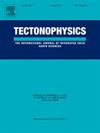Lithospheric electrical structure of Zhenghe-Dapu fault in South China determined by multi-geophysical observations: Implications for geothermal mechanism
IF 2.7
3区 地球科学
Q2 GEOCHEMISTRY & GEOPHYSICS
引用次数: 0
Abstract
The Zhenghe-Dapu fault (ZDF), situated in the Cathaysia Block of South China, has played a major role in the tectono-magmatic and geothermal activities in the region since Mesozoic-Cenozoic. However, the regional topography restricts the availability of surface heat flow data, hindering lithospheric thermal structure studies. Therefore, we used a broadband and long-period magnetotelluric profile with 33 points across the Cathaysia Block and ZDF to obtain a 3-D electrical conductivity model. Tectonic zones, such as the Jiangshao fault and ZDF exhibit high-resistivity (>1000 Ωm) blocks, interpreted as remnants of the cratonic lithosphere; low-conductivity areas (<100 Ωm) indicate lithosphere modified by materials derived from the deep mantle. A high-conductivity body (<10 Ωm) in the lower crust (~20–30 km) beneath the ZDF coincides with spatial position of low magnetic anomalies, high gravity, and low S-wave velocity. Moho depth (~34 km) is significantly greater than that in the adjacent areas (~28–32 km). Integrated geophysical observations suggest that the high-conductivity body may represent mantle-derived melt fluids ascending along faults, leading to the partial melting of lower crustal rocks. Mantle intrusion led to the thickening of the lower crust, that previously underwent regional thinning, ultimately resulting in the formation of a substantial amount of Mesozoic granite bodies, the radiogenic heat of which constitutes a major heat source. Since the Cenozoic, asthenospheric thermal material upwelling, magmatic underplating, and volcanic activity have provided heat to the upper crust. The radiogenic heat from the Mesozoic granites and Cenozoic magmatic-hydrothermal activities together contributed to the regional thermal anomaly, as supported by our resistivity model.
多地球物理观测确定的华南郑和-大浦断层岩石圈电结构:对地热机制的影响
郑河—大浦断裂位于华夏地块,自中新生代以来在该地区的构造岩浆活动和地热活动中起着重要作用。然而,区域地形限制了地表热流数据的可用性,阻碍了岩石圈热结构的研究。因此,我们使用横跨华夏地块和ZDF的33个点的宽带长周期大地电磁剖面来获得三维电导率模型。江绍断裂和ZDF等构造带呈现高电阻率(>1000 Ωm)块体,被解释为克拉通岩石圈的残余物;低电导率区(<100 Ωm)表明岩石圈被来自深部地幔的物质改造过。ZDF下地壳(~20 ~ 30 km)高导电性体(<10 Ωm)与低磁异常、高重力、低横波速度的空间位置重合。莫霍线深度(~34 km)明显大于相邻区域(~28 ~ 32 km)。综合地球物理观测表明,该高导电性体可能代表地幔源熔融流体沿断层上升,导致下地壳岩石部分熔融。地幔侵入导致下地壳增厚,下地壳之前经历了区域性变薄,最终形成了大量中生代花岗岩体,其放射成因热是主要热源。自新生代以来,软流圈热物质上涌、岩浆底板和火山活动为上地壳提供了热量。中生代花岗岩的放射性成因热和新生代岩浆热液活动共同导致了区域热异常。
本文章由计算机程序翻译,如有差异,请以英文原文为准。
求助全文
约1分钟内获得全文
求助全文
来源期刊

Tectonophysics
地学-地球化学与地球物理
CiteScore
4.90
自引率
6.90%
发文量
300
审稿时长
6 months
期刊介绍:
The prime focus of Tectonophysics will be high-impact original research and reviews in the fields of kinematics, structure, composition, and dynamics of the solid arth at all scales. Tectonophysics particularly encourages submission of papers based on the integration of a multitude of geophysical, geological, geochemical, geodynamic, and geotectonic methods
 求助内容:
求助内容: 应助结果提醒方式:
应助结果提醒方式:


